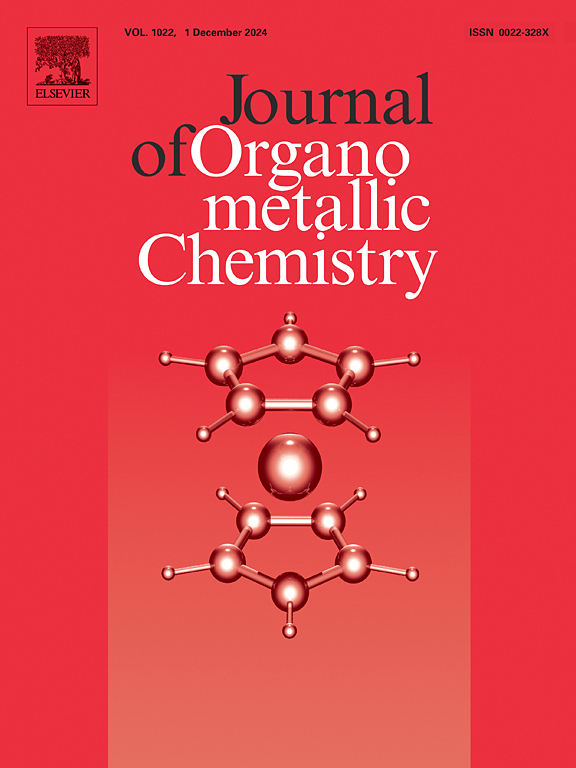Novel hybrid material of platinum (IV) nanocomplex-Carbon spheres: Synthesis, characterization, electrical conductivity and energy storage application
IF 2.1
3区 化学
Q3 CHEMISTRY, INORGANIC & NUCLEAR
引用次数: 0
Abstract
The preparation of supercapacitor electrodes using hybrid materials based on noble metal complexes represents a promising advancement for various biomedical applications. In this research context, a new binuclear Pt(IV) nanocomplex with bis-[1-(2-[(2-hydroxynaphthalen-1-yl) methylidene]amino}ethyl)-1-ethyl-3-phenylthiourea] Schiff base (Pt-L) was prepared and characterized by elemental analysis, ESI-MS, NMR, FT-IR, UV-Visible, TGA measurements, TEM, and cyclic voltammetry (CV). The formed nanocomplex was adsorbed on a graphite/carbon spheres mixture to prepare the Gr/CSs-Pt-L hybrid material for supercapacitor electrodes. The obtained composite was characterized by FT-IR, TGA, SEM-EDX, XRD, and electrical conductivity. In addition, the electrochemical studies, such as cyclic voltammetry (CV), impedance spectroscopy, and charge-discharge, were investigated using Au/Gr/CSs-Pt-L as supercapacitor electrode.
The TEM results showed that the platinum complex was synthesized in nanometric form, and SEM-EDX showed that this nanocomplex was well adsorbed on the carbonaceous support (Gr/CSs). The electrical conductivity study showed that Gr/CSs/Pt-L exhibits low activation energy, indicating that this material has the best activity because the minimum amount of the activation energy is required to initiate a chemical reaction. The electrochemical studies revealed that the Au/Gr/CSs/Pt-L electrode exhibits excellent pseudo-capacitive behavior, with a specific capacitance of 5060 mF.g−1, a high specific energy of 428 mWh.kg−1 and a specific capacitance retention that reaches up to 99.09 % at 1 A.g−1.
新型铂纳米配合物-碳球杂化材料:合成、表征、电导率及储能应用
利用基于贵金属配合物的杂化材料制备超级电容器电极在各种生物医学应用中具有广阔的前景。在本研究背景下,制备了一种新的双核Pt(IV)纳米配合物,该配合物具有双-[1-(2-羟基萘-1-基)甲基]氨基}乙基)-1-乙基-3-苯基硫脲]希夫碱(Pt- l),并通过元素分析、ESI-MS、NMR、FT-IR、uv -可见、热重分析、透射电镜和循环伏安法(CV)对其进行了表征。将形成的纳米配合物吸附在石墨/碳球混合物上,制备了用于超级电容器电极的Gr/CSs-Pt-L杂化材料。通过FT-IR、TGA、SEM-EDX、XRD、电导率等手段对复合材料进行了表征。此外,还对Au/Gr/CSs-Pt-L作为超级电容器电极进行了循环伏安法、阻抗谱、充放电等电化学研究。TEM结果表明铂配合物以纳米形式合成,SEM-EDX显示该纳米配合物在碳质载体(Gr/CSs)上吸附良好。电导率研究表明,Gr/CSs/Pt-L具有较低的活化能,表明该材料具有最佳的活性,因为它需要最少的活化能来引发化学反应。电化学研究表明,Au/Gr/CSs/Pt-L电极具有优异的赝电容性能,比电容为5060 mF。g−1,高比能428mwh。在1a.g−1时,电容保持率可达99.09%。
本文章由计算机程序翻译,如有差异,请以英文原文为准。
求助全文
约1分钟内获得全文
求助全文
来源期刊

Journal of Organometallic Chemistry
化学-无机化学与核化学
CiteScore
4.40
自引率
8.70%
发文量
221
审稿时长
36 days
期刊介绍:
The Journal of Organometallic Chemistry targets original papers dealing with theoretical aspects, structural chemistry, synthesis, physical and chemical properties (including reaction mechanisms), and practical applications of organometallic compounds.
Organometallic compounds are defined as compounds that contain metal - carbon bonds. The term metal includes all alkali and alkaline earth metals, all transition metals and the lanthanides and actinides in the Periodic Table. Metalloids including the elements in Group 13 and the heavier members of the Groups 14 - 16 are also included. The term chemistry includes syntheses, characterizations and reaction chemistry of all such compounds. Research reports based on use of organometallic complexes in bioorganometallic chemistry, medicine, material sciences, homogeneous catalysis and energy conversion are also welcome.
The scope of the journal has been enlarged to encompass important research on organometallic complexes in bioorganometallic chemistry and material sciences, and of heavier main group elements in organometallic chemistry. The journal also publishes review articles, short communications and notes.
 求助内容:
求助内容: 应助结果提醒方式:
应助结果提醒方式:


